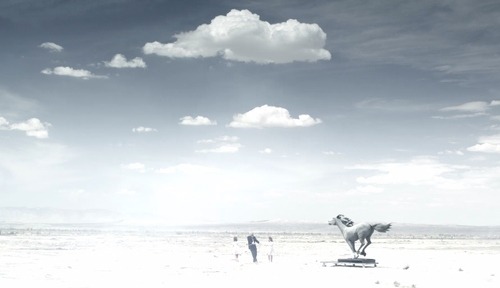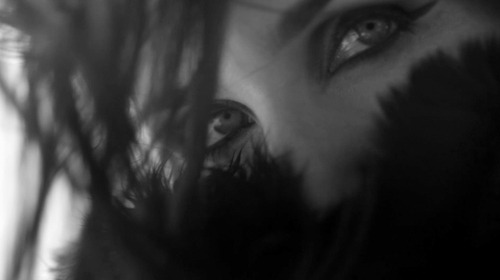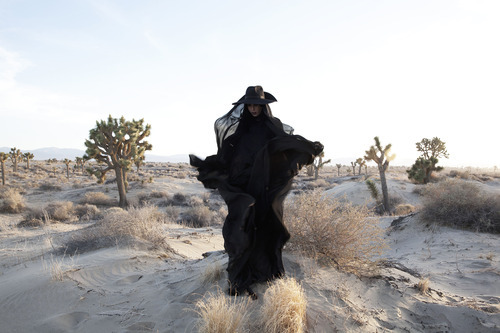Last month, LA-based folk metal chanteuse, Chelsea Wolfe, made her film debut with the release of…

Last month, LA-based folk metal chanteuse, Chelsea Wolfe, made her film debut with the release of Lone, an hour-long short film that bridges the divide between music video and short film. The surrealist/expressionist flick was directed by Mark Pellington, best known for directing Pearl Jam’s music video for “Jeremy” as well as videos for Nine Inch Nails, Foo Fighters, INXS, and Michael Jackson, and a handful of feature length films. Utilizing tracks from Wolfe’s 2013 record, Pain Is Beauty, the film visually explores the themes introduced on this album, which according to Pellington are “nature, sexuality, memory, mortality, forgiveness, love, innocence, fragility, violence, and beauty.”
Currently the film is not available to stream online, but curious fans can buy a USB key either online or at the Chelsea Wolfe merch booth. Currently on tour with Eels, Wolfe will be in Seattle this Saturday night playing an acoustic set at the Moore. I caught up with Wolfe on Monday night to learn more about Lone and her recent experiences on this spring tour.
What kind of film experience did you have going into making Lone?
I’d done a little bit of soundtrack work and a couple music videos here and there, but other than that I hadn’t really done a project like this before.

Tell me about working with Mark Pellington. What were some of the more profound lessons you gleaned from working with him?
I’d never really been pushed hard by a director before. That was actually a good new experience for me. The first day of filming, we were originally just going to do a music video for “The Waves Have Come” and he built this space to shoot in. The first day on set we started filming and instantly he was yelling at me and being very intense. Not yelling in a bad way, just to get me to feel the emotion of the song, to remember how I felt when I wrote it, urging me to really feel it and to get into it and giving me directions and things to envision while I was singing. That was really intense. The first take was a little overwhelming because there’s so many people on set watching you do this performance and I’m kind of a shy person. It was a little strange at first, but I immediately realized that that’s actually a really cool thing. Something I really grew to like about (Pellington) is how in the moment he can be. As soon as the cameras start rolling, he’s in control and he just guides you on this path. It worked out really well. I think we made a good team in the end.

What necessitated the film? What were you able to successfully express or communicate via the film that was missing from the record?
I don’t know that it was something that was missing from the record. As we were doing this music video, (Pellington) wanted to listen to the whole album together and realized that it was becoming something kind of cathartic and inspiring for him. He wanted to do a film based on five of the songs, so we expanded it from there. A lot of it was his vision. There was definitely back and forth between what each of us felt comfortable with and what symbols we wanted to have represented in the film, and even then I think they mean different things to each of us, but that’s kind of cool because we wanted to leave it a bit open to interpretation. It’s this very surreal dream world where each character represents something like shame or guilt or forward motion or memories. It just kind of came together naturally, from the music video to a short film.

How was the process of soundtracking the film different from your usual songwriting process? Were there any takeaways you’ll apply to your songwriting in the future?
One of my bandmates, Benjamin, is kind of a coconspirator on this project in many ways when it comes to the electronic songs and things like that because he’s really good at remixing. What we did for the additional soundtrack beyond the songs that were already recorded on the album is he kind of broke down a lot of the elements of the different songs and reworked them into new pieces as well as writing some new stuff for it. A lot of it was almost remixes of the strings in a certain song or just the synths of something and it brought it to a new emotional place.
You’re on the last leg of your spring tour. What have been some of the most memorable dates you’ve played so far?
This particular tour with the Eels is an acoustic one and pretty much all of the venues have been seated, which is a challenge. It’s something I’ve done before on my own headlining tour. It’s a totally different energy—I kind of forgot. It’s this totally different intimacy and this new challenge when people are seated. I think that the best show for this tour was actually the Denver show because there was actually an area, like a pit or whatever you wanna call it, where people could stand. I could really feel a higher energy from that just because I had been playing all of these seated shows. All of a sudden everybody was in my face and it actually felt really good, so that was a really good show. Last night we played at the Apollo theater in Harlem in New York and that was also really great just because it’s such a historical building. It’s so beautiful and you can kind of feel the history of it when you’re in it. We had a really good time there.
Why acoustic sets this tour? What made you wanna do that?
We’d just gotten off this rock ‘n’ roll tour with Queens of the Stone Age and we found out that Eels were doing it in a more stripped down style of upright bass and slide guitar and things like that. We just wanted to feed into that a little bit. I also was craving to do some acoustic stuff again, which might have been a curse because now that I’m doing it, I just want to go back to rock ‘n’ roll. It’s like the grass is always greener, you know what I mean? It’s cool to be able to do both things, and so we’re doing it—getting through it.

How do you feel the acoustic sets are different from your rock performances in terms of emotional tonality?
Honestly they’re both pretty emotional for me in the way that I try to be there in the song and in the moment and feel it, not just sing it but relate to it—not just repeat something that I’ve done before. I try to give it a little of a new life. With the acoustic sets you can hear a pin drop and everything is very minimal and very long and spread out. There’s all of this space when we do that set. Sometimes it can be a little scary. I think the rock ‘n’ roll set is, I don’t want to say easier, but it’s easier to be confident, I think. It’s easy to let go and move around and with the acoustic set, it’s more about stillness and feeling every little uncomfortable moment.
You seem to play a ton of shows around here. Tell me a little about your relationship with Seattle.
TJ Cowgill from King Dude and I are good friends and have been for a long time and make music together sometimes. I just really love Seattle in general. I don’t know if I can actually explain why, it’s just beautiful and green. When you drive into the city, it’s kind of magical. I’ve just always loved it up there. I love Oregon and I love Washington State, I love the West Coast in general, so it’s kind of a relief. Usually Seattle’s one of the first West Coast dates on a US tour, so you kind of feel like you’re home a little bit.
Chelsea Wolfe opens for Eels at the Moore Theatre on Saturday, June 7.

